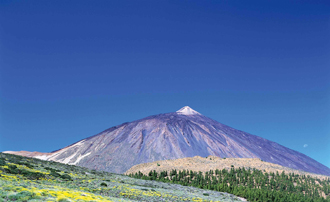
The Canary Islands and Tenerife's most visible landmark, Mt Teide, have been a point of reference for those who sailed between the Straight and the Atlantic coast since antiquity. On a world-wide level, the park is one of the island's few volcanic areas featuring ecosystem zones above the timberline, giving rise to unique ecosystems such as the alpine broom, and alpine ecosystems.
The use of plant species, water and snow as well as the extraction of minerals for diverse purposes marked a period of exploitation of the area's natural resources which came to an end when the area was declared a National Park in 1954, via a regulation governing the use of protected natural areas, and particularly, the Law on Reclassification of 1981 and the Use and Management Master Plan of 1984.
In 1981 the park was reclassified and received a new legal status. In 1989, the park was granted the highest award in the European Diploma of Protected Areas by the Council of Europe. This recognition of management and conservation was renewed in 1994, 1999 and 2004. The area consists of a large oval-shaped caldera with a 14 kilometre diameter. Although various suggestions have been made as to the origin of this caldera, the most widely accepted theory is that it was formed following a collapse of substrate as a result of an emptying of the magma chamber.
There are a total of 139 known species of vascular flora in the park, a third of which are native to the Canary Islands. The predominant vegetation in this area is the high mountain scrub, but there are also phanerogams, such as the Teide violet, and the Teide Edelweiss around the fumarole. We cannot forget the tajinaste and its characteristic change of colours. The park's fauna is dominated by invertebrates, with over 400 species, of which nearly 70% are native to the area, insects being the most abundant group.
In 2002, on the occasion of the 50th anniversary of the classification of Teide as a National park, park authorities initiated measures to have the park listed as a World Heritage Site by the United Nations Educational, Scientific and Cultural Organisation (UNESCO). On the 28th of June, after five years of hard work, the supranational organisation declared Teide National Park a World Heritage Site during the World Heritage Convention in Christchurch, New Zealand.


 Print
Print